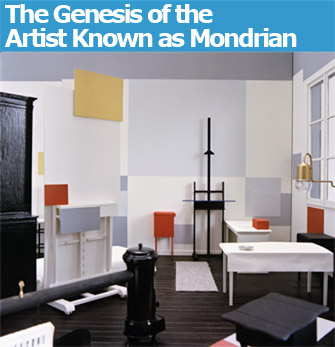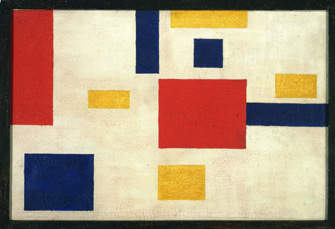 |
|
Nothing is left of Mondrian’s orderly Paris studio (at 26, rue de Depart), a work of art in itself, which has been recreated as it was in 1926 for the current show at the Centre Pompidou. © Adagp, Paris 2010 |
The mystery surrounding the work of Piet Mondrian (1872-1944) is only deepened by “Mondrian/De Stijl,” the excellent exhibition that opens today at the Centre Pompidou: how did Mondrian’s name …
 |
|
Nothing is left of Mondrian’s orderly Paris studio (at 26, rue de Depart), a work of art in itself, which has been recreated as it was in 1926 for the current show at the Centre Pompidou. © Adagp, Paris 2010
|
The mystery surrounding the work of Piet Mondrian (1872-1944) is only deepened by “Mondrian/De Stijl,” the excellent exhibition that opens today at the Centre Pompidou: how did Mondrian’s name become an international synonym for abstract, geometric arrangements of black strips and blocks of primary color and how could paintings that are so emotionless touch so many people so deeply and lastingly?
The main lesson of the exhibition is that Mondrian did not spring fully formed into life as the artist known as Mondrian. He spent years experimenting with styles originated by other artists – Symbolism, Impressionism, Fauvism, Cubism, etc. – before finally settling on his orderly formula of black grids with blocks of primary color, which he called Neo-Plasticism, meant to “link pictorial order with a social, spiritual and poetic utopia,” and sticking with it for pretty much the rest of his life.
The exhibition firmly places Mondrian’s work in perspective (notably lacking in his paintings). It starts by focusing on the philosophical basis for the De Stijl (The Style) movement: theosophy, a belief popular in the early 20th century, which held that the universe is underpinned by geometrical principles applicable to all cultures. Members of the De Stijl movement sought a “universal and rational pictorial language” to illustrate it.
Works by a number of the artists involved in the movement, notably Theo Van Doesburg, who invited Mondrian to help him launch the De Stijl journal in 1917, show them trying to represent the inner mind visually. Some of Mondrian’s attempts at the exercise seem gauche, such as “Dune Landscape” (1911), while others, like the Fauvist, nearly abstract “Red Cloud” (1907-09), are more successful.
Already well into his 30s, Mondrian moved on, trying other styles as they came along. The exhibition presents a very clear progression of his work through all the various styles, surrounded by works by other, now-lesser-
known artists who were experimenting with the same themes. We see Mondrian’s work respond to each movement, reacting especially strongly to the introduction of Cubism by Picasso and Braque, first with a rather lame attempt, then with more interesting and original works.
Cubism was a liberating force for Mondrian, offering him a way of seeing painting as no longer a means of individual expression or of depicting an object, but as a way of organizing space. Already, in conformity with theosophical theory, lines were ordering and giving rhythm to his paintings even when they were still figurative, as in his many experiments with images of trees, which became increasingly abstract until he finally started getting to the essence: geometry and pure color.
It took some time, however, before he reduced his works to grids and his palette to black, white and the three primary colors – a few rooms in the show are filled with abstract, geometric pieces from the late 1920s that still incorporate grays, pastel colors and fuzzy lines.
This mega-show, which concentrates on Mondrian’s Paris years, from 1912 to ’38, offers only a handful of works from his mature period, and it must not be forgotten that he came to his “Mondrian” style rather late in life, when he was in his 50s. It is interesting to note that the artist really struggled with and worked at these paintings, which can seem so reductive and formulaic: an unfinished canvas dating from 1934 shows how he kept changing his mind and moving the lines and blocks of color as he worked.
The music-loving Mondrian later introduced double and interlaced lines to his work, giving them a new rhythm and dynamism. The jazz-influenced “Boogie-Woogie” paintings (unfortunately, not in the show) done in New York near the end of his life, took a new direction, using rectangles of color rather than lines, and seem livelier and more human than his strict earlier works. Throughout his career, however, he never lost sight of the spiritual intention of his art: the colors were meant to absorb the environment of the room and guide the viewer toward a spiritual quest.
Van Doesburg is as strong a presence in this show as Mondrian, and one can’t help but wonder why Mondrian won the eternity sweepstakes while Van Doesburg, who quarreled with Mondrian over whether diagonal lines should be allowed in painting, fell into
 |
|
“Composition” (1917-18) by Georges Vantongerloo, another founder of the De Stijl movement. Photo: Philippe Migeat, Centre Pompidou © ADAGP, Paris 2010 |
relative obscurity. A talented artist himself, Van Doesburg often led the way for Mondrian and his other followers and seemed willing to take more risks.
The show offers glimpses into the lives of Mondrian and his De Stijl colleagues through photographs, letters, publications and a reconstruction of Mondrian’s Paris studio (pictured above). Probably the neatest artist’s atelier in history, it was laid out and painted like a Mondrian painting itself. In a series of interesting filmed interviews of people who knew Mondrian, one notes that he was a bachelor for a reason – “It would be impossible to live with him” – and that the often penniless artist would sometimes compromise his strict geometric principles to do a flower painting that he knew he could easily sell to one of his lady collectors.
The exhibition ends with a look at the application of De Stijl principles to other aspects of life, including architecture and design. The goal was to turn life itself into a harmonious work of art. The most spectacular piece is a reconstruction of the interior of the Schröder House designed by Gerrit Rietveld. Here we see modernity in the making, but we mustn’t forget that De Stijl was only one of several contemporary movements – among them Russian Constructivism and the Bauhaus – moving in similar directions.
For all his theories, was Mondrian’s art purely decorative? Can that explain its great appeal to the masses and why it looks so attractive when allowed to open up into architectural space, as in his studio or his never-realized plans (included in the show) for the decoration of a house in Dresden? Or should we simply thank Yves Saint Laurent for appropriating Mondrian’s designs for his 1965 collection?
Centre Pompidou: 19, rue Beaubourg, 75004 Paris. Tel.: 01 44 78 12 33. Open 11am-9pm. Closed Tuesday. Métro: Rambuteau. Admission: €10-€12. Through March 21, 2011. www.centrepompidou.fr
Order books on Mondrian from Paris Update’s Amazon store at no extra cost. Click on your preferred Amazon location: U.K., France, U.S.
Support Paris Update by ordering books from Paris Update’s Amazon store at no extra cost. Click on your preferred Amazon location: U.K., France, U.S.
Reader Reaction: Click here to respond to this article (your response may be published on this page and is subject to editing).
More reviews of Paris art shows.
© 2010 Paris Update
Favorite